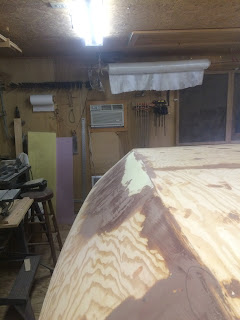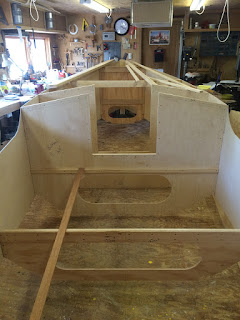So I want to take this moment to skip ahead a little bit. I'm about to make some rather time consuming mistakes and in my anticipation I want to gloss over some boring and fairly correct construction. The difficulty will be in the explaining. Pictures of course are helpful, but lighting and perspective are not things I readily do a fair job of manipulating when I start clicking away. So if this paragraph is already sounding like an apology for the rest of the content and a rationale for how poorly the explanation will be, you're correct. I buggered some things up, sorry.


These pictures look innocent enough. I screwed down the first ply of a two ply bottom then worked the bilge panels into place and started stitching them together. With the bilge panels in place I noticed my first red flag. Near the rear of the boat, at station 11 the bilge panels had some serious overlap with the bottom. I worked them back and forth and found no happy compromise between the overlap. However, they fit quite nicely from the stem back to this point, thus I determined that it wasn't just me getting crazy with the jigsaw, but something is wrong with the bulkhead at this location.

A trick Papa recommended doing from time to time on any curved surface to check for fairness, was to lay a batten strip over the area in question, stretching the batten strip as far as possible to see how a natural bend out to look. Starting at the front, I was pleased to see the curves stretching from the bow towards the middle of the boat looking fine on both the bilge panels and the bottom. However, when I laid the batten on the bottom from stern to bow, I saw a gap under the strip, nearly an inch, stretching the width of the bottom.

Okay okay don't tell me, "wait Calvin didn't you say something about a bulkhead being too short when you were assembling and you were going to piece something under it?"
Yeah and I did okay, there it is right there. That little piece glued under the bulkhead fills the gap wonderfully from the corner to the limber hole. "Yeah, that looks good, so you must have put a strip under the entire width of the bulkhead too, but wait it looks like the bottom is already glued on in this picture...and you're doing the fillets of epoxy already...so, that means..."
Yeah it means my bottom ply has an enormous dip in it at this spot and it's not coming apart without some serious destruction. Again, like pretty much everything in life, the extra minutes you spend in accurately preparing your foundation save you hours later in patchwork solutions.
Can I fix it? Yes. Do I need to? Define "need." Papa says nobody may ever know it's there, but you always will. Yeah, I need to fix it. If nothing else, the bottom is about to get some serious reinforcement and as it happens, right under where 500 lbs of ballast will be mounted someday. I'm okay with this. Granted the plans already call for a stout 1 inch thick bottom, but what the hell, I'll put two layers of fiberglass over it later too, just so I can feel better about all the beaches that I'll be running her up on.

Now I've noticed when I make a mistake that I can't quite fathom the consequences of, I stand back and make sort of a "huh" sound. You know how midwesterners are so darn nonjudgmental out loud, all while stewing their brains out inside and looking for an exit. When you're out at a local social gathering and you mention to some new aquantences how you used to take your favorite pet chicken sledding when you're were a kid.
"That's different."
Yeah you bet the hell it was different. Anyway without going into my childhood definition of a good time any further, I tap my inner Minnesotan. I stand back and say "huh, interesting." Papa doesn't say anything. His mind is looking for solutions already while mine is whirring about deconstructing social and cultural differences of the northern American homo sapient.
"You can fill in the space with pieces of 1/4" plywood and this fiberglass matting, gaining nearly an inch in the center, the deepest part, and feathering it by stepping the thickness down." Brilliant, and when it's all complete the second full ply will cover the mess and hopefully have a gentle, beautiful, and fair curve from end to end.
Don't worry, if you thought this bullet just got dodged, it didn't. I just pushed the issue from the bottom to the sides. With the bottom looking fine, we get the batten back out and find some interesting bilge panel shape. Good thing I like sanding.
That's different.
 So If I had to guess, and boy do I love guessing, I'd say this boat is pushing 800 pounds already. 'Course you know how guessing goes, it's what got this whole mess started in the first place.
So If I had to guess, and boy do I love guessing, I'd say this boat is pushing 800 pounds already. 'Course you know how guessing goes, it's what got this whole mess started in the first place.




























